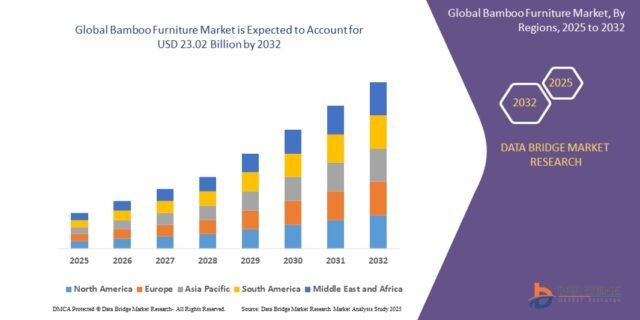Introduction
The bamboo furniture market is experiencing robust growth, fueled by increasing global awareness of sustainable living, eco-friendly material usage, and modern interior design trends. As a renewable resource, bamboo offers a compelling alternative to traditional hardwoods. It grows rapidly, requires minimal pesticides or irrigation, and offers strength and durability that rival conventional timber.
Bamboo furniture includes a wide range of products—from chairs, beds, and tables to decorative shelving and outdoor furnishings. Its combination of natural aesthetics, strength, and sustainability appeals to both residential consumers and commercial establishments such as hotels, resorts, and eco-conscious office spaces.
Source – https://www.databridgemarketresearch.com/reports/global-bamboo-furniture-market
Market Overview
Bamboo is often considered the steel of the plant world, owing to its exceptional tensile strength. Its fast growth cycle—up to 3 feet per day in optimal conditions—makes it one of the most sustainable materials available. Unlike hardwoods, which may take decades to mature, bamboo can be harvested within 3 to 5 years.
The bamboo furniture market is segmented based on product type, application, distribution channel, and geography. As green construction and sustainable design gain global prominence, the demand for bamboo furniture has surged across both developing and developed regions.
Key Market Drivers
1. Rising Environmental Awareness
Consumers and businesses are increasingly choosing products that reduce their carbon footprint. Bamboo furniture, made from a fast-renewing resource, aligns with these values and is viewed as an environmentally responsible choice.
2. Aesthetic Appeal and Versatility
Bamboo’s natural grain and smooth texture make it ideal for a variety of interior styles, including rustic, minimalist, contemporary, and tropical themes. Its ability to be stained, varnished, or left natural enhances its design flexibility.
3. Urbanization and Residential Growth
The rise in urban housing, especially compact apartments and eco-friendly dwellings, supports demand for lightweight, modular bamboo furniture. It’s often easier to transport and install compared to traditional furniture.
4. Government Support for Sustainable Materials
In several regions, governments and environmental agencies promote the use of renewable resources like bamboo. Some policies encourage bamboo-based construction and manufacturing as part of broader climate strategies.
5. Expanding Hospitality and Tourism Industry
Eco-resorts, sustainable hotels, and themed restaurants are increasingly furnishing their spaces with bamboo products to reinforce their environmental credentials and natural aesthetics.
Market Segmentation
By Product Type
- Chairs and Stools
- Tables (Dining, Coffee, Side Tables)
- Beds and Bedframes
- Sofas and Loungers
- Shelves and Storage Units
- Outdoor and Patio Furniture
By Application
- Residential
- Commercial (Offices, Cafés, Hotels)
- Outdoor Spaces (Gardens, Terraces, Poolside)
By Distribution Channel
- Online Retail
- Offline Retail (Furniture Stores, Specialty Stores)
- Direct Sales and Custom Orders
By Geography
- North America
- Europe
- Asia-Pacific
- Latin America
- Middle East & Africa
Regional Insights
Asia-Pacific
This region dominates the market due to the natural abundance of bamboo, particularly in countries like China, India, Indonesia, and Vietnam. Traditional knowledge of bamboo craftsmanship combined with growing export capabilities makes Asia-Pacific a key production hub.
North America
Growing interest in sustainable living, coupled with the popularity of minimalist and nature-inspired interiors, is boosting demand in the United States and Canada. Many consumers are shifting toward bamboo furniture for its environmental benefits and design appeal.
Europe
The European market is also growing steadily, supported by strong sustainability initiatives, green building codes, and demand for high-quality, imported eco-friendly furniture.
Latin America and Middle East & Africa
These regions are gradually embracing bamboo as part of eco-tourism infrastructure and modern residential architecture. Market penetration is increasing due to awareness campaigns and pilot projects promoting bamboo’s use in furniture and construction.
Market Challenges
- Durability Concerns: While bamboo is strong, some consumers still perceive it as less durable than hardwoods. Ensuring high-quality treatment and manufacturing standards is critical.
- Limited Skilled Labor: In regions unfamiliar with bamboo processing, a lack of skilled artisans and manufacturing expertise can hinder local production.
- Pricing and Import Costs: In non-producing regions, transportation and import duties can make bamboo furniture more expensive than locally sourced alternatives.
- Standardization Issues: The absence of universally accepted quality standards for bamboo furniture can lead to market inconsistency and consumer skepticism.
Opportunities
- Eco-Luxury Furniture Lines: Premium bamboo furniture with sophisticated finishes and custom designs can attract high-end markets.
- Public Sector Adoption: Governments and public institutions can use bamboo furniture in offices and schools to promote sustainability goals.
- Green Certifications and Branding: Eco-labels and third-party sustainability certifications can enhance credibility and appeal to environmentally conscious buyers.
- Modular and Multifunctional Designs: Developing compact, transformable bamboo furniture can appeal to urban dwellers with limited space.
Competitive Landscape
The bamboo furniture market includes a mix of traditional craftsmen, local manufacturers, and global eco-furniture brands. While Asia-Pacific remains the manufacturing stronghold, North America and Europe host a growing number of sustainable furniture startups.
Companies often differentiate themselves through craftsmanship, design innovation, and environmentally responsible practices such as using water-based adhesives and low-VOC finishes.
Customization services, direct-to-consumer online models, and collaborations with interior designers are also key growth strategies.
Future Outlook
The bamboo furniture market is poised for continued growth as consumers, businesses, and governments increasingly value sustainability, aesthetics, and functionality. Innovations in bamboo treatment and design, alongside marketing that highlights bamboo’s eco-friendly benefits, will be essential in driving future adoption.
As awareness expands and production techniques improve, bamboo furniture will transition from a niche segment to a mainstream option in global furniture markets. Companies that invest in quality, branding, and sustainable practices will be well-positioned to lead in this evolving landscape.







